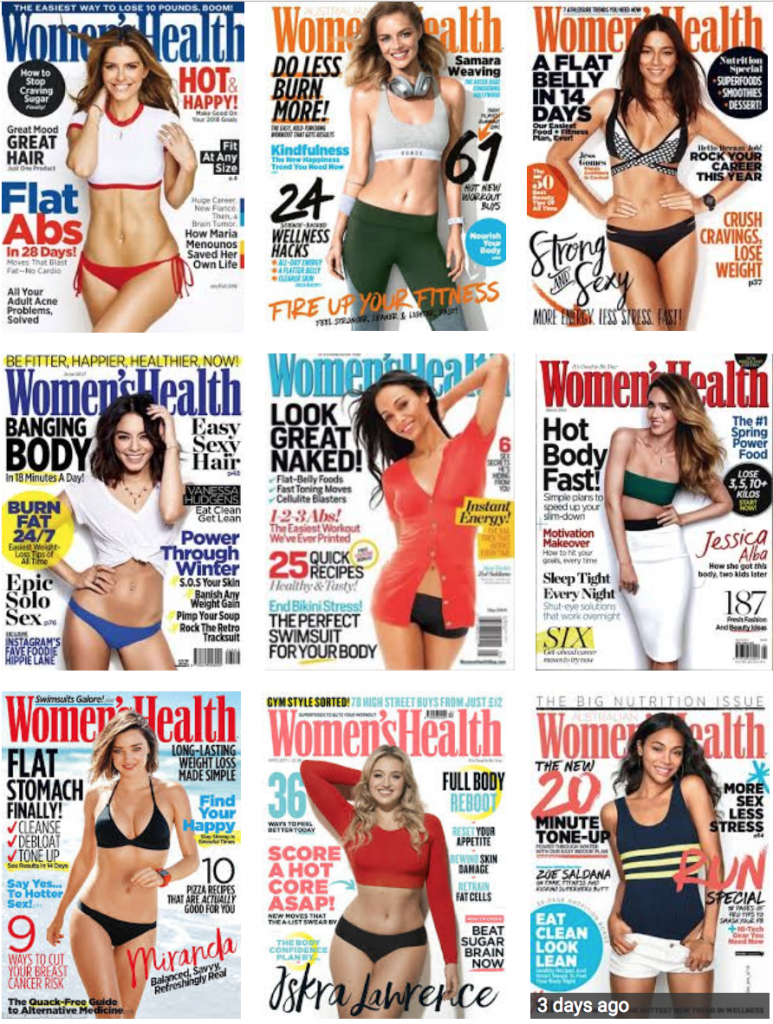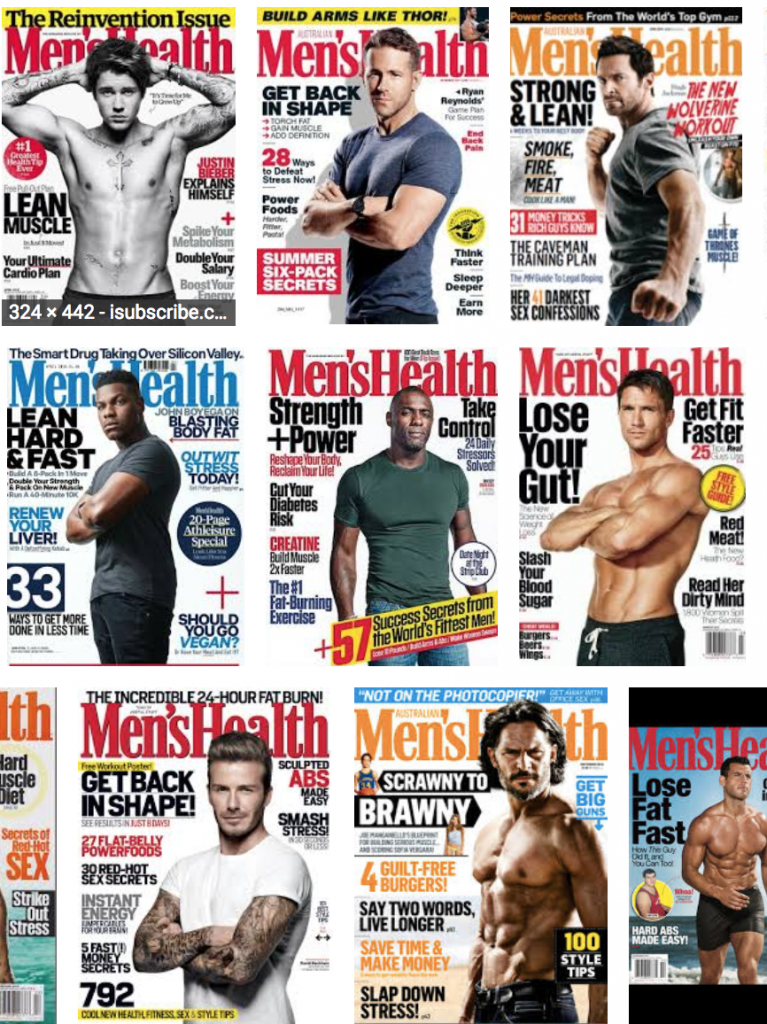By Sarah Rowe
Last week, while making a last-minute run to the supermarket to grab some household essentials, two images caught my eye as I hastily scanned my purchases at the self-serve checkout. One was the cover of “Women’s Health” and the other the cover of “Men’s Health.” The women’s edition featured an anonymous bikini clad female, her long, shining hair blown back from her coy, smiling face. Surrounding her were various headlines, alluding to happiness, a better body, a better sex life and, of course, the promise of weight loss (which is, obviously, a prerequisite to all of the benefits above).

The men’s cover featured a presumably well-known male sports figure, staring at the camera, basketball grasped between his hands, poised for action. The headlines boasted tips on, yes, burning fat but also how to “Get XXL Arms!” and “Double Your Stamina.”
Something about those two very different images and the clouds of words surrounding them stuck with me long after I had unpacked my groceries. It occurred to me that both magazines claim to promote health. Yet the imploring headlines differed greatly.
Ideals of “health” are clearly gendered. It appears that health for women entails being slim, sexy, and having an aesthetically pleasing physique, while health for men is about being big, strong, fit and tough.
Women’s Health Magazines
A key theme that emerges in women’s health magazines is that women should always strive to be smaller. We are taught that we should take up less space in this world. There is no doubt that words like “flat,” “slim” and “tight” are all underscored by a common theme: smaller is better. Magazines implore women to shrink themselves in the name of health and well-being. Conversely, men are taught to be bigger. They are encouraged to grow, to take up space, to be strong. They are encouraged to build big muscles, to gain strength, to “Get XXL Arms.”
Also, women’s health magazines covertly imply that women’s bodies are only valued for their aesthetic quality and that the ideal aesthetic is to be small, while still being sexually desirable to men. The woman on the specific cover of the magazine that caught my eye was anonymous; she was valued for nothing more than her figure, held up as an unattainable ideal that women should strive for.
Features in women’s magazines often focus on achieving a more desirable figure; they promise to help us “Look Great Naked” and get “Lean Sexy Legs” or obtain a “Great Butt!” The problem with all these headlines is that they cloak themselves as being driven by a concern for health, but really what they are pushing women to do is achieve a certain look—slim and stereotypically sexy. Also, the functional benefit of having a “Great Butt” or “Lean Sexy Legs” is not the point here. The point is that having a perky behind or shapely legs is pleasing to the opposite sex and makes a woman more sexually desirable.
In the name of health, women are expected to modify their bodies, not to enhance their overall function or obtain health benefits, but to make their bodies more sexually appealing to men. Perhaps the most glaringly obvious example of this is the headline “Look Great Naked.” This blatantly endorses exercise and a “healthy” diet not for the purpose of enhancing overall health and well-being, but to improve one’s overall attractiveness and sex appeal.

Men’s Health Magazines
On the other hand, men’s health magazines focus less on aesthetics and more on function. The man on the cover of the men’s health magazine was, I assume (admittedly I don’t have much of an interest in sports) a well-known male athlete. Unlike the anonymous woman, his body is arguably valued for what it can do, rather than how it looks. This plays out in the common feature articles of men’s magazines as well. For example, male bodies are valued for their “Strength and Power,” rather than slim and sexy. Men are encouraged to be “Lean, Hard, Fit & Fast,” rather than to look good sans clothes.
The emphasis on men’s bodies and their power also plays into conceptions of male sexuality. Messages of strength and power in men’s health magazines contribute to the concept that men should be strong and dominant in the bedroom. Men’s health magazines encourage men to increase their physical stamina and endurance, enabling them to “Go Longer, Go Harder!” and have “Wild Sex!” Sex isn’t linked to their appearance, it’s related to their strength. On the other hand, with women it is implied that in order to have great sex, one must first feel sexy and, in order to feel sexy, one must work towards having a conventionally sexy physique. All of these reveal a clear pattern: male bodies are valued for what they can do, female bodies are valued for how they look.
While these disparities between the way health is portrayed in men’s and women’s magazines may seem innocent enough, they are arguably sinister in that they feed into confining historical and harmful gender roles. They reproduce narrow constructions of female and male roles. For example, they contribute to the idea that women are something to be admired and pursued. Meanwhile, they portray men as strong, dominant and capable—their value is contingent on their strength, what they can do and achieve. They reinforce the supposed passivity of women, and the supposed dominance of men. They encourage the objectification of women, the breaking of the female form down to mere body parts, each of which must be toned, chiselled and smoothed to conform to and satisfy the male gaze. Such constructions of gender are arguably harmful to both women and men.
Admittedly, I have in the past been guilty of buying “Women’s Health,” and I cannot guarantee that I won’t fall victim to the allure of its glossy pages filled with promises of a better life and self-improvement in the future. But perhaps next time I’ll flick through the pages with a critical eye and a skeptical mind and question whether the ideals being promoted encourage genuine well-being or are just patriarchal norms thinly veiled under the guise of health. I would encourage you to do the same.